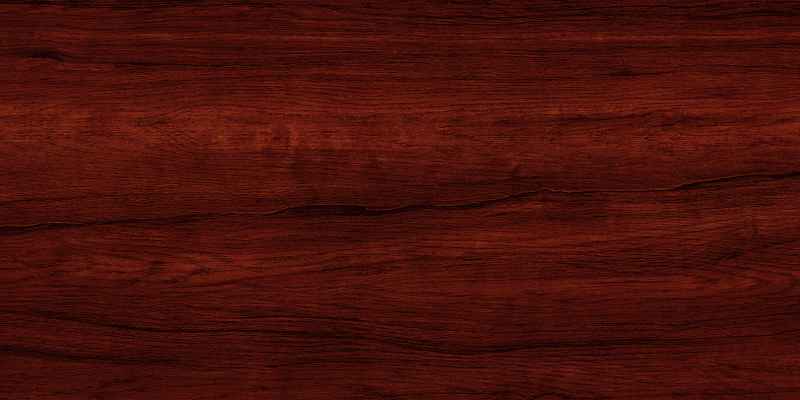Purpleheart wood is a type of hardwood known for its distinctive and striking deep purple color. It is prized for its unique tonal properties, making it highly sought-after in the guitar community.
Purpleheart wood is extremely strong and dense, making it one of the strongest and densest trees available in the market. However, its hardness and natural oils can be challenging to work with, as they dull saw edges and clog up cutting and drilling tools.
Despite this, purpleheart wood is rot and insect resistant, making it suitable for exterior projects such as decking or dock material. The scientific name of the tree that produces purpleheart wood is Peltogyne, and it is primarily found in Central and South America.
Characteristics And Uses
Purpleheart wood, scientifically known as Peltogyne, is a rare, exotic hardwood renowned for its unique deep purple color. It is native to the tropical rainforests of Central and South America, particularly in countries like Brazil, Suriname, and Guyana. This wood species has gained popularity in various woodworking applications due to its exceptional characteristics. Below, we delve into the main attributes and applications of purpleheart wood.
Strength And Density
Purpleheart is esteemed for its remarkable strength and density, making it one of the toughest and most durable woods available. Its Janka hardness rating averages around 1860 lbf, indicating its exceptional resistance to wear and tear. The wood’s density contributes to its outstanding durability, suitable for applications requiring robust materials, such as flooring, decking, and heavy-duty furniture construction.
Rot Resistance And Durability
Notably, purpleheart wood boasts significant resistance against rot and insect infestation, rendering it a reliable choice for outdoor applications. Its natural oils and density provide unparalleled protection, making it a preferred material for exterior decking, structural beams, and marine construction.
Tonal Properties
When it comes to tonal properties, purpleheart wood holds a strong presence in the musical instrument industry. It is particularly sought after for guitar fretboards due to its bright and articulate tone with a well-defined attack. With a balanced tonal response, including a tight low end, pronounced midrange, and crisp highs, purpleheart wood is highly prized by luthiers and musicians for crafting high-quality fretboards and instrument components.
Processing And Working
Purpleheart wood is known for its stunning purple color and exceptional strength. However, working with this unique wood comes with its own set of challenges. From effects on processing equipment to the difficulties in working with the wood itself, it is important to understand how to handle purpleheart wood to achieve the best results.
Challenges In Working With Purpleheart
Working with purpleheart wood can be a challenging task due to its density and hardness. Here are some of the challenges you may encounter:
- Toughness: Purpleheart is one of the strongest and densest trees available, making it difficult to cut and shape.
- Blunting of Tools: The natural oils present in purpleheart wood can dull the edges of saws and other cutting tools.
- Resin Buildup: Purpleheart wood contains resin that can clog up cutting and drilling tools, leading to reduced efficiency and performance.
Effects On Processing Equipment
The unique properties of purpleheart wood can have an impact on processing equipment. Here’s how:
| Effect | Description |
|---|---|
| Dulling of Saw Blades | The hardness of purpleheart wood can quickly dull saw blades, requiring frequent sharpening or replacement. |
| Resin Clogging | The resin in purpleheart wood can build up on cutting and drilling tools, reducing their effectiveness and necessitating regular cleaning. |
| Increased Wear and Tear | Due to its density, working with purpleheart wood can put more strain on processing equipment, leading to faster wear and tear. |
Despite these challenges, the unique beauty and strength of purpleheart wood make it a popular choice for various woodworking projects. By using the right tools and techniques, you can overcome these obstacles and create stunning pieces that showcase the richness of this remarkable wood.
Varieties And Alternatives
Purpleheart wood is known for its striking purple color, durability, and unique tonal properties, making it a popular choice in various woodworking projects. However, there are other types of purpleheart wood and alternatives available for those looking for similar characteristics and aesthetics.
Other Types Of Purpleheart Wood
While purpleheart wood primarily refers to the Peltogyne genus, there are other species that share similar characteristics:
- Peltogyne Paniculata: Also known as Amaranth, this variety offers a deep purple color and excellent durability for outdoor projects such as decking or dock material.
- Peltogyne Venosa: This species features a reddish-brown hue with purple undertones, adding a unique touch to any woodworking project.
Alternatives To Purpleheart Wood
If you’re looking for alternatives to purpleheart wood, consider these options:
- Paduak Wood: With its vibrant orange-red color that darkens over time, paduak wood is an excellent alternative for achieving a bold and eye-catching look. It is also durable and can withstand outdoor conditions.
- Brazilian Rosewood: Known for its luxurious dark brown color and excellent resonance qualities, Brazilian rosewood is a popular choice for musical instruments and high-end furniture.
- Wenge Wood: With its deep chocolate brown color and unique grain pattern, wenge wood offers a striking and sophisticated aesthetic. It is also highly durable and suitable for various woodworking applications.
- Black Walnut: Featuring a rich dark brown color and a lustrous grain, black walnut is a versatile wood option that can be used in both fine furniture-making and decorative projects.
Exploring the different varieties and alternatives to purpleheart wood allows you to find the perfect wood type that suits your specific project needs and personal preferences.
Applications
Purpleheart Wood, known for its rich purple hue, is a popular choice for high-end furniture and decorative items. This exotic wood is prized for its durability and unique color that deepens with age. Craftsmen value its vibrant appearance in various woodworking projects.
Decking And Dock Material
Purpleheart wood is notably resilient and well-suited for outdoor applications such as decking and dock material. Its exceptional durability and resistance to rot make it an ideal choice for these purposes. It maintains its strength and stunning purple hue even in harsh weather conditions.
Furniture And Designs
When it comes to crafting furniture and innovative designs, purpleheart wood offers a touch of elegance. Its vibrant purple color, combined with its robust nature, makes it a popular choice for creating stunning pieces of furniture and intricate designs. From tables and chairs to decorative elements, purpleheart wood lends a sophisticated and luxurious appeal to any craftsmanship.
Where Does It Come From
Purpleheart wood comes from a tropical tree known as Peltogyne, with a scientific name of Peltogyne spp. This tree is native to the Central and South American regions.
Origin Of Purpleheart Wood
The origins of Purpleheart wood can be traced back to the Amazon Basin in Brazil and other parts of Central and South America.
Availability In Central And South America
Purpleheart wood is widely available in the Central and South American regions, where the tree grows abundantly in dense tropical forests.
Color Change
Purpleheart wood is known for its stunning natural purple color, but did you know that this color can change over time? The unique color change of Purpleheart wood adds to its allure and makes it a popular choice among woodworkers and craftsmen.
Factors Influencing Color Change
Several factors can influence the color change of Purpleheart wood:
- Sunlight Exposure: When exposed to sunlight, Purpleheart wood undergoes a natural process called oxidation. Over time, the vibrant purple color fades to a deeper, rich brownish hue. This color change can be accelerated when the wood is used outdoors or in areas with high levels of natural light.
- Aging: Like fine wine, Purpleheart wood gets better with age. As it matures, the wood develops a darker and more pronounced color, adding depth and character to your finished projects.
- Staining and Finishing: The process of staining and finishing Purpleheart wood can also affect its color. Different types of stains and finishes can either enhance or alter the natural purple hue, allowing you to achieve a customized look.
Staining And Finishing
When it comes to staining and finishing Purpleheart wood, there are a few things to keep in mind:
- Preparation: Before applying any stain or finish, it is crucial to properly prepare the wood surface. This involves sanding the wood to a smooth finish and ensuring it is free from dust and debris.
- Test Samples: Since Purpleheart wood can react differently to stains and finishes, it is recommended to test samples on scrap pieces of wood to determine the desired color and finish.
- Application Technique: When applying stain to Purpleheart wood, consider using a brush or cloth to evenly distribute the stain. Allow the stain to penetrate the wood for the recommended time before wiping off any excess.
- Finishing Touch: Once the stain has dried, applying a topcoat or finish can help protect and enhance the color of Purpleheart wood. Choose a finish that complements the desired look, whether it’s a glossy or matte finish.
Overall, understanding the color change of Purpleheart wood and how staining and finishing can impact its appearance allows you to create beautiful, customized projects that showcase the unique beauty of this wood species.

Frequently Asked Questions On What Is Purpleheart Wood
Why Is Purple Heart Wood So Expensive?
Purpleheart wood is expensive due to its origin in rainforests, logging restrictions, export limits, and transportation costs. Its challenging nature further adds to its price.
What Are The Disadvantages Of Purple Heart Wood?
Purpleheart wood is extremely strong and dense, making it one of the toughest trees available. However, its hardness and natural oils can dull saw edges and clog cutting and drilling tools. Additionally, the wood is expensive and challenging to work with.
Is Purple Heart A Good Tone Wood?
Purpleheart wood is highly sought after in the guitar community for its unique tonal properties, contributing to a bright and articulate tone with a well-defined attack. It offers a balanced tonal response with a tight low end, pronounced midrange, and crisp highs.
It is a good tonewood for guitars.
Is Purple Heart Wood Rot Resistant?
Yes, purple heart wood is rot resistant and commonly used as decking or dock material. It is the third hardest wood and offers insect resistance, making it suitable for outdoor projects. With a UV sealant, it maintains its color while providing durable performance.
Conclusion
Purpleheart wood is a highly sought-after hardwood known for its distinctive deep purple color. This unique tone wood is favored by guitar enthusiasts for its bright and articulate sound. Additionally, its rot and insect resistance make it a popular choice for decking and outdoor projects.
However, its density and natural oils can present challenges during processing. Despite its cost and difficulty to work with, Purpleheart wood remains a valuable and exquisite material for various applications.


